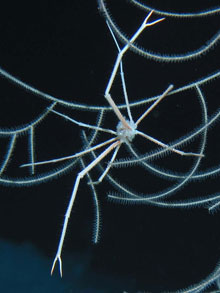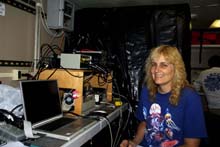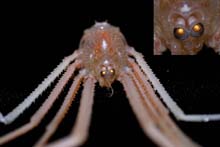
Figure 1. A Gastroptychus spinifer (squat lobster) climbs on a sea pen. Click image for larger view and image credit.
Eyes That Talk
July 27, 2009
Tamara Frank
Expedition Chief Scientist
Harbor Branch Oceanographic Institution/Florida Atlantic University
While bioluminescence is a fascinating phenomenon in its own right, equally fascinating is determining how animals are adapted for seeing bioluminescence. As downwelling light travels through the water column, the longer wavelengths are absorbed, and the shorter wavelengths are scattered, leaving behind only blue light. In addition, most of the marine bioluminescence that’s been studied so far is also blue. Therefore, one would expect deep-sea species to have a single, blue-sensitive visual pigment , as that’s the only light that’s down there, or so we thought.
Vision in living deep-sea benthic (bottom dwelling) animals had never been studied before, due to the nearly impossible task of recovering them from the depths without exposing them to high temperatures or blinding light levels on the trip to the surface. However, with specially designed traps, light-tight insulated containers to place them in, and the skill and patience of the Johnson-Sea-Link (JSL) submersible pilots, who manage to find and collect animals under dim red light, we managed to get them up alive and do the first-ever physiological studies on their eyes.
On an NOAA Ocean Explorer-funded expedition in 2005, I got a teasing glimpse of an extraordinary visual adaptation in a deep-sea benthic crab, a squat lobster called Gastroptychus spinifer (figure 1). In my 2005 crab specimen, I found evidence of its ability to see ultraviolet (UV) light. However, I had only this one animal, and in science, a sample size of one is not enough, particularly when trying to claim that a deep-sea animal can see a color that’s not supposed to be in the deep-sea. On this expedition, I was thrilled to collect two more specimens of the same species. I have just finished my experiments, which demonstrate clearly that these crabs indeed have a UV-visual pigment.
![]() A squat lobster, Gastroptychus spinifer, seems quite at home perched on a sea whip and feeding.
A squat lobster, Gastroptychus spinifer, seems quite at home perched on a sea whip and feeding.

Figure 2. Tamara Frank with everything she needs to "speak crab." Click image for larger view and image credit.
Since I don’t "speak crab," how do I determine what this crab sees? I let its eyes do the talking. First, I build a light-tight room in the corner of the shipboard lab, using an ocean-going scientist’s favorite supplies — black plastic, duct tape, and PVC pipe. Because these are deep-sea animals, they have incredibly sensitive eyes, so any exposure to room lights would permanently blind them. As soon as we get them to the surface in their light-tight boxes on the JSL, we remove the boxes from the sub and transfer them to light-tight boxes in a cold room under dim red light. I then set them up in my experimental chamber without exposing them to room light.
Once inside my black room, I place an electrode on one eye under dim red light, and shine lights of different colors and intensities on the eye. A light guide transmits light from outside the dark room through a slit in the black plastic onto the animal’s eye, letting me run the experiments from the well lit lab rather than crouched in a hot, stuffy plastic box (figure 2). Based on the size of the response, I can tell what color the crab sees best.

Figure 3. The squat lobster has a body that is about 1/2-inch wide and 1-inch long. Its eyes are quite large for such a small animal. Click image for larger view and image credit.
Gastroptychus spinifer, the UV-sensitive crab, has quite large eyes for such a small animal. This particular species was collected at around 600 meters (1,969 feet) (figure 3). The question is: why does an animal at these depths have such large eyes with a UV-visual pigment when there isn’t any UV light? Well, finding the answer is one reason why we’re out here studying benthic bioluminescence, a.k.a. living light. Bioluminescence has to be the answer, as that’s the only potential source of UV, or near-UV, light down at these depths.
We’re collecting as many benthic animals as we can with the submersible, measuring them for their bioluminescence potential (scientific lingo for rubbing them and squeezing them to see if they glow), and then measuring the color of the light they emit with a sophisticated instrument called a spectrometer. Hopefully, we’ll soon be able to solve the mystery of UV vision in a deep-sea crab.




















